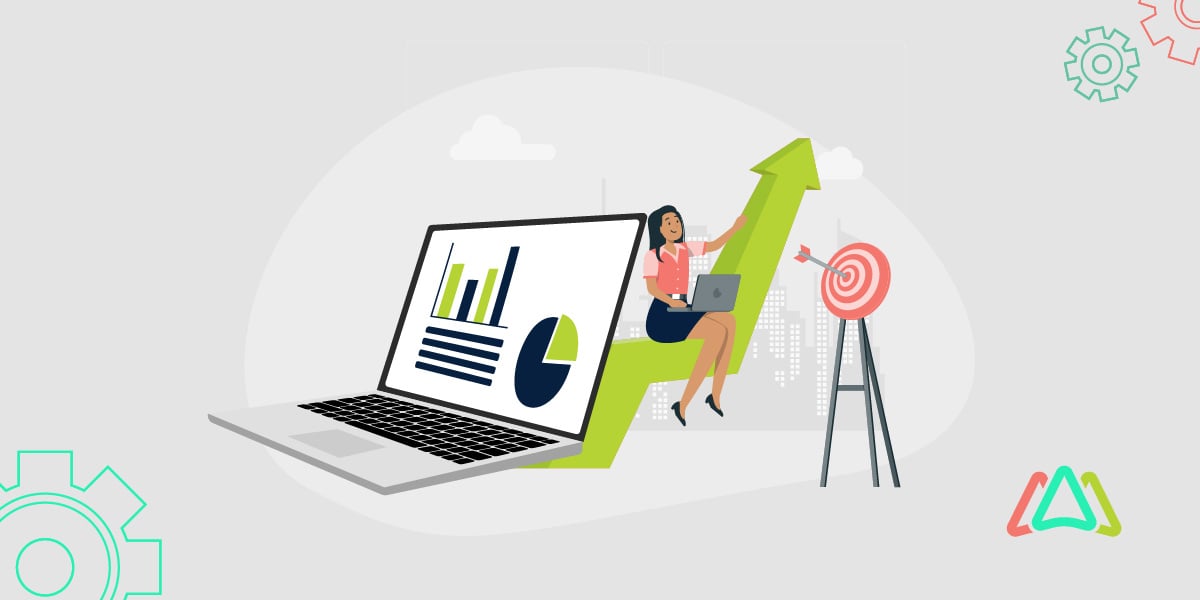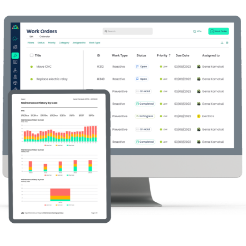
Scaling CMMS Software for Growing Businesses
Introduction
A Computerized Maintenance Management System (CMMS) is software designed to help business operations by streamlining maintenance activities and processes. More specifically, CMMS software assists in tracking assets, managing work orders, scheduling preventive maintenance, and storing maintenance-related data, all in one centralized system. These functions translate to improved efficiency, reduced downtime, better business resource management, and a higher bottom line.
As businesses grow, so do their maintenance needs. For this reason, a scalable CMMS is essential because it can adapt to an organization’s expanding requirements. A scalable CMMS ensures that the software can grow with the company by handling increased assets, users, and additional operational locations without compromising performance. CMMS scalability is critical in maintaining the same level of efficiency and effectiveness even as a business expands. It also avoids having to make costly software replacements or significant overhauls. Finally, it is crucial to long-term success in dynamic, growth-focused environments.
Understanding CMMS Scalability
Scaling a CMMS involves ensuring the system can manage increasing demands as a business grows. This means the software can manage more data, accommodate more users, and seamlessly integrate with additional processes or locations.
Definition of Scalability in CMMS
Scalability in the context of CMMS refers to the system’s ability to grow alongside a business. A scalable CMMS should be able to increase its capacity without posing significant performance issues or excessive costs. As a company’s maintenance operations expand, the CMMS adapts to change, supports the growing business’s needs, and still provides accurate reporting and performance tracking.
In simpler terms, scalability ensures that the system remains efficient, cost-effective, and responsive, regardless of the scale of operations. The goal of scalability is to future-proof the CMMS so that it continues to meet the evolving needs of a growing organization.
Factors Influencing CMMS Scalability
Several key factors affect the scalability of a CMMS. Understanding these factors helps businesses select a system that can effectively support their growth without needing constant upgrades or replacements. Let’s explore some of them.
Number of Assets Managed
As businesses grow, they typically acquire more assets. A scalable CMMS must be able to handle an increasing number of assets across multiple departments, locations, or facilities. This includes managing different types of equipment, vehicles, or machinery and ensuring that each asset’s maintenance history is tracked and updated.
Volume of Inventory Items
As an organization’s inventory management needs grow, the CMMS must also scale to manage a larger volume of parts and supplies, and ordering processes. This includes tracking stock levels, managing reorders, and ensuring spare parts are available to prevent maintenance delays.
Size and Structure of Maintenance Teams
A growing business usually involves increasing the size of its maintenance team. A scalable CMMS should allow seamless integration of new users while supporting the complexities of different roles and responsibilities. Whether adding new technicians, supervisors, or managers, the system must accommodate these changes without a drop in performance or usability. The business may require more secure user access as the volume of users grows. Companies should consider secure user management tools like SSO, 2-factor authentication, and active directory.
Number of Operational Sites
For businesses that expand geographically, the CMMS must be capable of handling maintenance operations across multiple locations. This includes tracking assets and work orders at each site, providing real-time data and insights, and ensuring each location’s unique needs are met without redundancy or error. If locations are spread across different geographical locations, the CMMS might should support different timezones, date formats, currencies and languages.
Integration with Other Departments
As a business scales, better integration between departments is often needed. A CMMS must be able to communicate with other systems, such as accounting, procurement, and human resources. For example, integrating with inventory management or procurement systems helps streamline the process of ordering parts or scheduling maintenance based on financial or operational priorities.
Desired Maintenance Service Levels and KPIs
Business growth may also lead to more stringent maintenance requirements or the need to track more detailed key performance indicators (KPIs). A scalable CMMS must support advanced reporting capabilities, more detailed performance metrics, and customizable dashboards. All these features are designed to help management track service levels and performance over time.
Recognizing the Need to Scale Your CMMS
Business expansion is good, but it also requires change in several aspects of an organization’s operations. This is especially true in maintenance management, even those managed by a CMMS. A system that once worked well may show inefficiency as operations expand. This is likely the time to consider scaling a CMMS to maintain productivity and avoid operational disruptions. The following are key indicators that suggest your CMMS needs to be scaled.
Expansion to New Locations
Managing maintenance across multiple sites becomes more complex when a business expands to multiple sites. A CMMS that is not scalable may be limited in its ability to:
- Coordinate maintenance activities across various facilities.
- Provide a centralized view of maintenance data for all locations.
- Ensure consistent maintenance policies and procedures.
Increase in Asset Acquisitions
Growth often means investing in more equipment, vehicles, or infrastructure. A CMMS that is not designed for scalability may be challenged by:
- Slower performance due to a higher volume of asset data.
- Difficulty tracking maintenance history for an increasing number of assets.
- Problems setting up preventive maintenance schedules for new assets.
Growth in Maintenance Personnel
As maintenance teams grow, a system that can accommodate more users becomes critical. Signs that your CMMS may need to scale include:
- Limited user licenses prevent the addition of new team members.
- Difficulty assigning roles, permissions, and responsibilities to new employees.
- Less than optimal communication and workflow management between team members.
Enhanced Maintenance Objectives
As companies grow, their maintenance goals often evolve as well. For example, businesses may shift from reactive maintenance to more proactive strategies such as predictive maintenance. A CMMS without scalability may have difficulty with the following:
- Supporting advanced maintenance strategies.
- Generating detailed reports and analytics to track new performance metrics.
- Integrating with IoT devices or other technology for real-time condition monitoring.
Scaling a CMMS ensures that your operations remain efficient and adaptable to change. By proactively identifying these signs, businesses can take timely action to scale their CMMS before inefficiencies start affecting productivity.

Strategies for Effectively Scaling CMMS
As was the case when a CMMS was initially implemented, scaling requires a strategic approach, too. Without a proper CMMS scaling plan, businesses may encounter inefficiencies, data inconsistencies, and user adoption challenges. Below are key strategies for successfully scaling a CMMS:
Assessing Current and Future Requirements
Like when you first researched a CMMS before the organization expanded, businesses must evaluate their current maintenance processes and anticipate future needs. This involves:
Conducting a Needs Assessment:
Identify current challenges and inefficiencies in the CMMS, such as slow performance, lack of integrations, support for single-site only, lack of multi-language and currencies, or difficulty managing increasing work orders.
Projecting Future Growth:
Estimate how many additional assets, locations, users, and maintenance activities the CMMS will need to support over the next several years.
Reviewing System Capabilities:
Ensure the existing CMMS can scale. Alternatively, determine whether an upgrade or migration to a more robust system is necessary.
Implementing Scalable CMMS Solutions
Selecting a CMMS with built-in scalability features is the key to long-term success. A scalable CMMS should:
Support Modular Growth:
A scalable CMMS can add new features, locations, or modules (e.g., mobile access, IoT integration) as needed without requiring a complete system overhaul.
Allow Flexible User Management:
It also can add and manage an increasing number of users with different roles and permissions. It should also support more advanced and secure user management tools like SSO (Single-Sign-On), Active Directory, and 2-factor authentication.
Maintain Performance as Workloads Increase:
The CMMS should be able to manage larger datasets and increase maintenance activities without slowing down or crashing.
Offer Cloud-Based Solutions:
Cloud-based CMMS software is scalable by nature. These systems allow businesses to increase storage, processing power, and accessibility as operations grow.
Data Management and Integration
As businesses expand, data management becomes more complex. Properly organizing and integrating data in a scalable CMMS ensures the system provides accurate insights and operational efficiency.
Ensuring Data Consistency:
Standardize asset naming conventions, maintenance schedules, and reporting formats to avoid inconsistencies when adding new assets or locations.
Preparing for Seamless Integration:
This involves ensuring the CMMS can connect with other essential business systems such as ERP (Enterprise Resource Planning), inventory management, and procurement software.
Managing Data Growth:
Effective CMMS scalability involves implementing data archiving strategies to prevent excessive system load while keeping historical maintenance records accessible.
Effective data management allows businesses to maintain a clear and accurate view of maintenance operations, even as the volume of information increases.
Training and Change Management
Scaling a CMMS is more than a technical upgrade—it also requires user adoption and process adjustments. Resistance and inefficiencies are potential issues that companies face without proper training and change management in place when undergoing CMMS scalability. Some things to consider are the following:
Providing Comprehensive Training:
Educating existing and new employees on how to use the expanded features of the CMMS.
Implementing Change Management Strategies:
Addressing employee concerns ensures smooth transitions when adding new locations, assets, or workflows.
Offering Ongoing Support:
Establishing help desks, user manuals, or regular refresher courses to ensure staff can fully use the CMMS as it scales.
Implementing these strategies will ensure businesses can maintain seamless maintenance operations, improve efficiency, and support long-term growth without the risk of outgrowing their CMMS.
Challenges in Scaling CMMS and How to Overcome Them
Scaling a CMMS can present challenges that, if not properly addressed, may hinder maintenance operations and overall business efficiency. Understanding these challenges and implementing effective solutions is essential for success during company expansion and CMMS scalability.
Data Overload and System Performance Issues
Challenge:
As businesses grow, data stored in the CMMS—such as work orders, asset histories, and inventory records—can become overwhelming. Without scalability, a CMMS can easily experience performance issues such as slow processing, data retrieval delays, and system crashes.
How to Overcome It:
- Use cloud-based CMMS solutions that offer scalable storage capacity and faster processing.
- Regularly archive older data while keeping essential maintenance records accessible.
- Regularly assess system performance to identify and address bottlenecks before they impact operations.
- Ensure the CMMS being used can handle large amounts of data and that the system architecture is designed to operate efficiently when loading large amount of records.
Difficulty in Managing Multiple Locations
Challenge
Managing maintenance in multiple locations can become challenging as a business expands geographically. Without a scalable CMMS, companies may struggle with inconsistent data, redundant processes, and difficulty tracking maintenance across different facilities. Other challenges include accomodating multiple languages, different curriencies, different date formats, and timezones.
How to Overcome It:
- Cloud solutions facilitate real-time data access across multiple sites, ensuring consistency.
- Establish uniform maintenance protocols for all locations to maintain consistency in data entry, work orders, and asset tracking.
- To prevent data confusion, assign user permissions based on location and job roles, ensuring that only relevant personnel can modify records.
- Ensure that you initially find a CMMS that supports different time zones, date formats, currencies, and languages out of the gate; otherwise, if these become requirements later as the business scales, you’ll be shopping for a new CMMS.
User Adoption and Training Gaps
Challenge:
As businesses expand, new employees come onto the maintenance team. This means existing employees must adapt to an evolving system. Without proper training, user adoption rates may be low, leading to inefficient CMMS usage, data entry errors, and frustration.
How to Overcome It:
- Offer training sessions, video tutorials, and documentation to help employees stay updated on CMMS features.
- Take advantage of built-in help tools, notifications, and guided workflows to ease new users into the system.
- Create a feedback loop where employees can report issues or suggest improvements for a better user experience.
Integrating with Other Business Systems
Challenge:
As businesses grow, they may need their CMMS to integrate with other enterprise systems, such as ERP (Enterprise Resource Planning), inventory management, and procurement platforms. Poor integration can lead to data silos, inefficiencies, and manual data entry errors.
How to Overcome It:
- Ensure that the CMMS you select supports API (Application Programming Interface) integrations for seamless data exchange with other systems.
- Collaborate with internal IT teams or CMMS providers to design custom integrations and automated workflows.
- Conduct rigorous testing before full implementation to prevent integration failures and data inconsistencies.
Cost Management and Budget Constraints
Challenge:
Scaling a CMMS often requires additional licensing, infrastructure upgrades, or new features, which increase costs. Businesses with budget constraints may struggle to justify these expenses.
How to Overcome It:
- Focus on must-have scalability features. Add-on features look good at first glance, but they may not justify the cost if they are unneeded.
- Consider cloud-based CMMS solutions with flexible pricing, which allow businesses to scale up or down based on their budget and needs.
- Track CMMS performance improvements (e.g., reduced downtime and maintenance costs) to demonstrate its financial benefits to stakeholders.
- Leverage your legal and procurement team (if you have) to negotiate contracts with favorable terms; get volume discounts written into the contract for future growth, set fixed pricing on based on longer term multi-year agreements.
Ensuring Data Security and Compliance
Challenge:
As the CMMS scales, more users will gain access to it, which may pose security concerns. Moreover, businesses in regulated industries must comply with maintenance and asset management standards.
How to Overcome It:
- Assign user permissions based on job roles to prevent unauthorized access to sensitive data.
- Stay updated on industry regulations and ensure the CMMS supports compliance reporting (e.g., SOC Type 2, FDA, OSHA, ISO).
- Ensure that the CMMS software provider complies with standards and has the necessary certifications (HIPAA, GDPR, ISO27001, SOC2, etc.)
- Conduct regular security audits, implement data encryption, and use multi-factor authentication (MFA) for added protection.
Addressing these challenges ensures that maintenance operations remain efficient, cost-effective, and adaptable to future growth. By implementing the right strategies, businesses can maximize the benefits of their CMMS and support long-term operational success.
Conclusion
As businesses grow, maintenance operations become more complex, making it essential to scale CMMS software effectively. A well-scaled CMMS ensures that organizations can manage increasing assets, multiple locations, growing maintenance teams, and evolving maintenance strategies without sacrificing efficiency or data accuracy.
As previously noted, scaling your CMMS is not just an IT upgrade—it’s a strategic move to future-prior maintenance operations. If your business is experiencing rapid growth, ensure your CMMS is equipped to handle expansion.
You can do this by evaluating your current CMMS capabilities, considering a cloud-based or modular CMMS solution that offers flexibility and scalability, talking with CMMS providers to explore solutions tailored to your business size and industry, and investing in training and change management to ensure seamless adoption as you scale.
By taking these steps, your organization can enhance its maintenance efficiency, reduce downtime, improve asset management nt, and set the stage for long-term operational success.
TABLE OF CONTENTS
Keep Reading
Ever find yourself checking into a luxury hotel and expecting a relaxing stay, only to find a ...
11 Apr 2025
Organizations are witnessing swift changes in the business environment and confronting a ...
8 Apr 2025
Last month, news outlets and the entire internet was abuzz with the return of NASA astronauts ...
3 Apr 2025
What comes first - CMMS or predictive maintenance? If your answer is either, it is correct. ...
28 Mar 2025
Artificial intelligence (AI) talk has become commonplace. Today, engaging in business-focused ...
27 Mar 2025
Imagine a world where machines predict, diagnose, and fix their issues before they fail. This ...
25 Mar 2025
A facility maintenance plan is at the core of a facility’s operations. This organized ...
21 Mar 2025
Think of managing your maintenance operations like managing a championship sports team. Just ...
21 Mar 2025
The maintenance sector is battling a severe talent shortage that threatens to undermine ...
7 Mar 2025
Manufacturing maintenance is the backbone of industrial efficiency, ensuring machines run ...
5 Mar 2025
No one likes playing a guessing game when equipment breaks down. Yet, maintenance teams often ...
4 Mar 2025
The size of the preventive maintenance software market is discussed in millions of dollars, ...
4 Mar 2025
The organizational structure and corporate hierarchy vary from company to company. Large ...
28 Feb 2025
Maintenance procedures are essential for ensuring the longevity and reliability of machinery ...
21 Feb 2025
Sustainability is no longer just a buzzword; it's a critical component of corporate social ...
20 Feb 2025
A Computerized Maintenance Management System (CMMS) relies on accurate, well-organized data ...
18 Feb 2025
In an era where technology drives operational efficiency, Computerized Maintenance Management ...
14 Feb 2025
A Computerized Maintenance Management System (CMMS) is a key component of modern maintenance ...
13 Feb 2025
Introduction Maintenance management is the foundation of maintenance operations in industries ...
11 Feb 2025
Introduction Due to a growing awareness of the need to combat climate change, the green ...
6 Feb 2025






